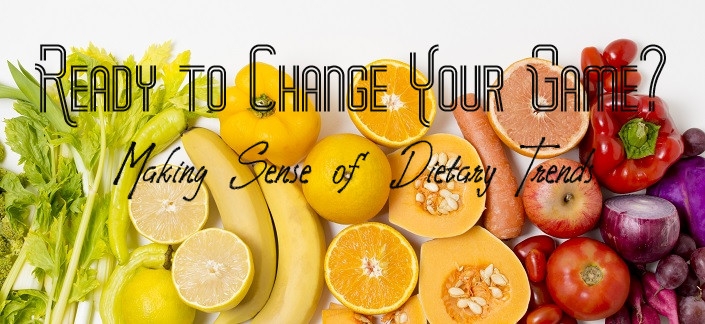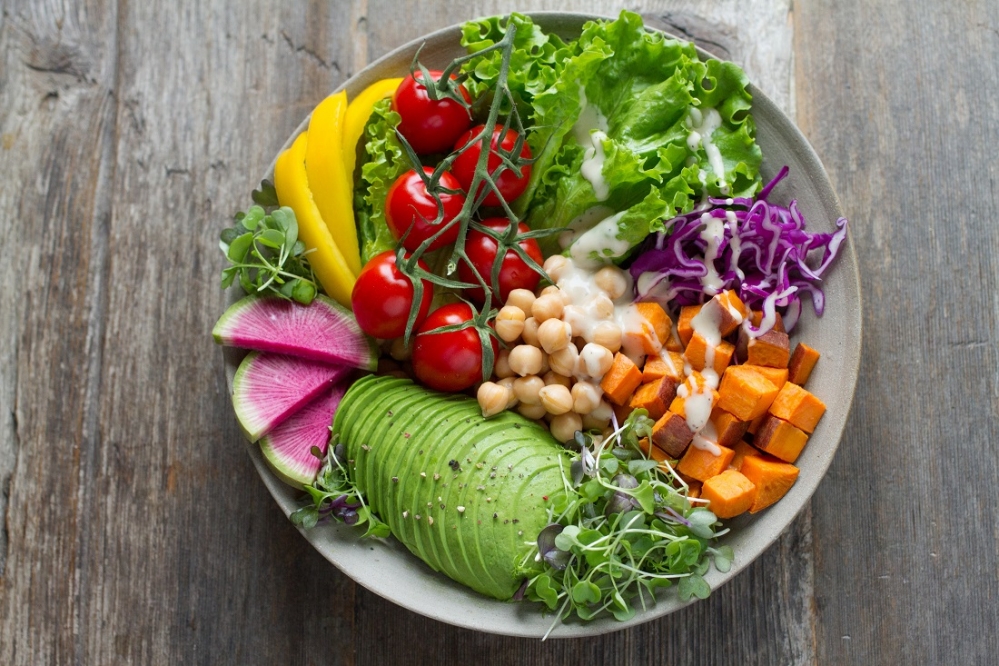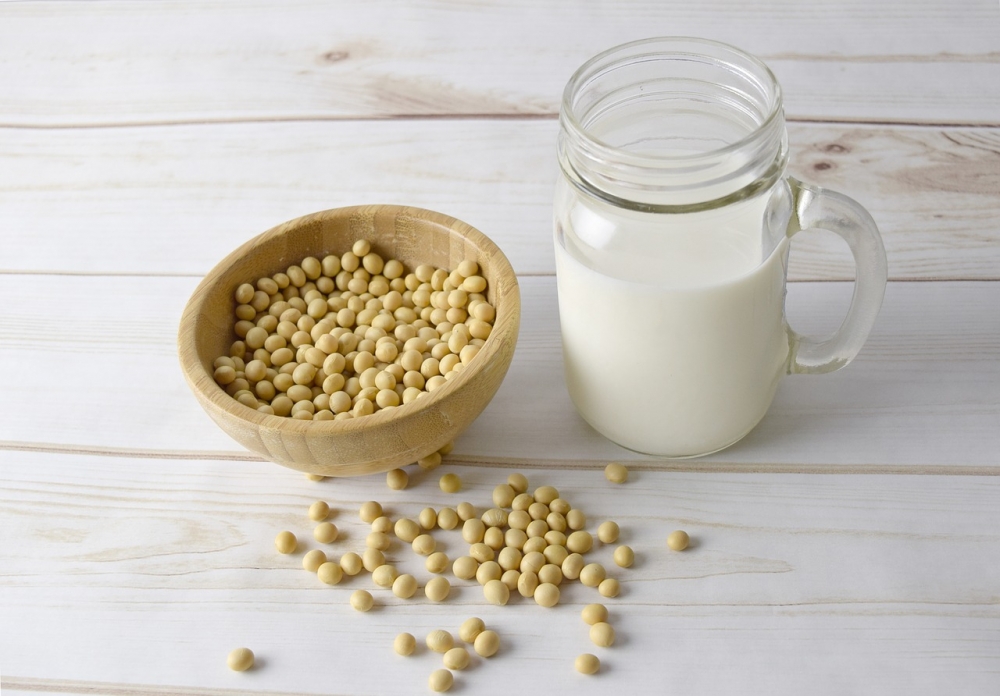Ready to Change Your Game? Making Sense of Dietary Trends

Author: Gavin Deguara, ND, Nutr. Med.
It’s hard to escape the buzz of a new dietary trend when it’s plastered all over social media, discussed in social circles and even promoted by celebrities. At the moment, intermittent fasting, ketogenic programs and plant-based diets are getting plenty of attention.
Yet one diet is standing head and shoulders above the rest when it comes to media coverage and heated debates that even scientists have trouble getting to the bottom of.
Since the release of The Game Changers documentary on Netflix, there has never been quite as much buzz surrounding plant-based and vegan diets. It has become the biggest selling documentary of all time on iTunes, promoting a move to either complete veganism or a plant-based dietary focus.
Youtube now contains dozens of hours of interviews, which aim to debunk The Game Changers, with several bunks of the debunk, and on and on it goes ... one of which is Joe Rogan’s four-hour epic podcast with Chris Kresser and one of the producers from the documentary, James Wilks.
For many, however, the move to a plant-based diet isn’t just about nutrition. In fact, for some, the motivation for this change doesn’t involve nutrition at all.

Some draw motivation for vegan diets from a planetary health perspective, their own spiritual, mental and emotional wellbeing, and animal welfare concerns.
Few would dispute that there is still a tremendous amount to be done when it comes to respect for animals, in addition to striving for more ecologically sound farming practices.
Moreover, who could argue against anyone choosing to not eat animal products out of a desire to preserve and protect animal life? These are deeply personal decisions.
But is this a case of getting environmental and ethical concerns mixed up with nutritional needs. After all, our nutritional requirements aren’t influenced by our belief systems—as far as the field of science can determine, anyway.
No doubt for many, ethics and the preservation of life is a higher principle with to be adhered at all costs, even to the detriment of nutritional status and optimal health.
Is there such a cost to be payed though?
With enough nutritional and scientific scrutiny we are driven back to a very basic and fundamental question: how well do we really understand human nutritional requirements?
Though the human health message is getting less murky with each passing decade, the waters are still far from crystal clear. The slow pace of quality peer-reviewed published research, unbiased by industry, means that more evidence is needed to truly understand the complexities of human nutrient requirements.
Whether you’d like to debunk or bunk The Game Changers documentary, tear it to shreds or put it on a pedestal, many medical and nutritional professionals agree that a diet composed of primarily plant-based whole foods seems to be the way to go for the majority of people.

Dietary Trends: Fad or Genetic Birthright
The countless number of dietary fads that have stormed their way through societies over the years have proven that the public is desperate for ways to improve their health.
And that’s no surprise given the rates of serious morbidity in developed nations. In Australia, chronic disease is responsible for 90% of illness, disability and death1.
The trickiest part of assessing the benefits of a newly adopted diet is being objective, and finding separation between the feel-good effect, seemingly full of potential to fashion a new you, and the real and long-term health benefits.
The power of the mind to create our reality is undisputable, also known as the placebo effect. And the more social media hype and expectations built into our motivation for change, the more we can expect our mind to influence our health in the short term.
This exemplifies just how powerful our minds really are. If we could only harness that power, constantly, for positive change in our health and lives …
That’s not to say adopting a new dietary strategy won’t work wonders nutritional for you.
In fact, most dietary trends have a lot in common. They call for the removal of processed, packaged and take-away food and motivate for a generally healthier approach to eating.
This in itself is often enough to significantly improve health, irrespective of the other principles wrapped up in the core the dietary model.
Another factor to consider when you are assessing a new diet is the fact that they often contain higher concentrations of micronutrients and phytochemicals that were previously low in our diet, due to a lack of food variety.

After all, deficiencies of micronutrients, like vitamin D (sunshine vitamin), iodine, zinc and so many more are common in developed nations, despite the fact that we overconsume total calories2,3,4.
Whether it’s a plant-based diet or a fully vegan one, a quality diet always requires careful planning, shopping, food preparation and cooking—unless you have the luxury of an experienced chef with a solid background in nutrition.
These are all important points to consider when you are considering a new dietary approach, and in hind sight assessing how it impacts your health and quality of life.
Though it’s pretty much impossible to be completely objective, these factors should help decrease the subjectivity inherent in dietary assessment and personal health outcomes.
Vegan Micronutrients and Omega 3
Most people following a vegan or vegetarian eating plan are aware of keeping an eye on their Vitamin B12 and iron levels.
It can actually take a few years for someone with a no B12 coming in through their diet or supplements to start experiencing signs and symptoms of deficiency, given that they had a decent level to start with. This is typically how long it takes the liver to run out of its stores of this essential vitamin.
And iron deficiency can happen much faster, especially for menstruating women. Anemia is a massive global health issue, affecting 1.62 billion people or just a hair under a quarter of the world’s population. Half of this is believed to be due to iron deficiency5.
The bioavailability of iron from meat compared to plants is significant. Heme iron sources are absorbed at a rate of around 15-35%, compared to plant sources at 2-20%6.
That’s not to say that you have to eat meat in order to be iron replete. It just means, keep an eye on it. Get your levels tested and be aware of the signs and symptoms or iron deficiency.
Many simply take an iron and B12 supplement daily or every other day in order to keep their levels topped up. Just go for a chelated or glycinate form of iron for a higher bioavailability and a methylcobalamin type of B12.
Cyanocobalamin is still good, but the methyl forms will overcome any genetic polymorphisms affecting B12 activation.
Iron and B12 aside, there are plenty of other nutrients to watch out for when adopting a vegan or plant-based diet, such as zinc, choline, EPA and DHA.
And then there are amino acids, dipeptides and tripeptides, which are beyond the scope of this article to discuss, such as Carnitine, Creatine and Beta-Alanine.
And this isn’t to detract from a vegan approach to diet. All diets tend to have their strengths and weaknesses in this day and age. Many adopts a vegan diet and have no issues at all. But an informed approach always helps.
Though a vegan diet can provide most essential nutrients, EPA, DHA and B12 are not available. Though if you get your hands on some organic white button mushrooms (Agaricus bisporus), these can provide at least some B127.
Nori seaweed is also a source of vegan B12, providing 77.6mcg B12 per 100g dry weight product. This makes it possible to reach the Australian RDI for women (non-pregnant and not breastfeeding) and men of 2.4mcg/day with a little over 3 grams of Nori daily8.

However, the RDI is the absolute bare minimum required to meet our daily needs, given that we don’t have a deficiency. So it is certainly worth investing in a supplement unless your dietary practices are incredibly disciplined. Even then it is still important to monitor blood levels.
The importance of EPA and DHA for human health cannot be overstated, even though they are not termed essential fatty acids. The starting molecule, linolenic acid, is an omega 3 fat that the body uses to synthesize EPA and DHA.
Research indicates that the human body is a poor converter of linolenic acid into EPA, and especially DHA. Approximately 1% of linolenic acid is converted to DHA, while most western diets don’t contain enough omega 3 to begin with9.
The richest sources of the Omega 3 fatty acids EPA and DHA are seafood, though some is also found in algae. Omega 3 fats offer profound cardiovascular benefits, reduce systemic inflammation and support healthy mood and cognition.
It’s important to remember that the RDAs are set with the minimum amount of a nutrient to not cause short-term disease. For instance, the RDA for vitamin C prevents scurvy in 95% of people, though more vitamin C than the RDA supports optimal health.
Optimal health is what most people are really looking for in developed nations, which means hitting the tiny amounts of nutrients set out in the RDAs becomes a low standard, like topping your car up with fuel and oil only to the lowest markers.
So what on earth is optimal health, really?

Though there is no set definition, optimal health is more about chronic disease prevention, for conditions like type 2 diabetes, cardiovascular disease and dementia.
In addition, optimal health is also about having more daily energy and a better mood, better defenses against infection and a greater psychological stress tolerance.
Couple that with more fitness and lean mass, including muscle tissue, and less body fat, and we arrive at some idea of optimal health.
This is where scientists start looking at optimal levels of nutrient intake, rather than the minimum requirement to meet basic needs and survival.
A Single Perfect Global Diet?
It would be a tough ask to convince a carnivore-diet adherent miraculously recovering from a decades-long severe autoimmune disease that a vegan diet is the way to go.
The same goes for suggesting to someone following a vegan diet and feeling healthier and more vibrant than ever before that they need to incorporate red meat into their daily diet.
For every diet out there, of which there are countless, there is a staunch adherent who will swear until they lose their voice that this is the diet that’s got the answers.
And these days, diets have become akin to religious practice, striking as much fervor, discussion and heated debate as their spiritual counterparts.
Scientific research is pointing to one stark nutritional reminder, however. We are all a bit different, with slightly different nutritional needs, and therefore varied responses to diet.
For instance, the nutritional significance of choline is not well known by the public. Since 1998, choline has been deemed an essential nutrient that needs to be obtained from the diet, despite the fact that the human body can synthesize it (though not enough).
Dietary choline deprivation research on humans shows that 77% of men, 80% of post-menopausal women and 44% of pre-menopausal women developed choline deficiency, indicated by fatty liver and muscular dysfunction10.
The richest dietary sources of this nutrient aren’t commonly consumed on a vegan or vegetarian diet, such as liver (most pates), eggs, soy flour and salmon. However, soy flour is close to the richest source, making it a viable dietary option for vegans11.

Given the above percentages regarding choline deficiency, it could be easy to see how some may do better on a standard vegan diet versus an omnivorous one. After all, how many omnivores eat eggs or salmon regularly, versus vegans and soy flour?
Some synthesize more choline than others and also require less. If you have higher choline needs and have difficulty synthesizing it, you may be less likely to respond to a standard vegan diet favourably over time.
Fortunately, soy flour is relatively inexpensive (and safe to eat regularly) and there are plenty of choline supplements, such as lecithin and phosphatidylcholine capsules, either of which can be soy or sunflower sourced12,13.

A meta-analysis published in 2013 indicated that zinc bioavailability from plant sources is lower than animal sources, due to the higher phytic acid content in plant-based diets. Vegetarian diets were shown to contain less zinc as well, with lower serum (blood) values for those sticking to a vegetarian diet14.
Every food group has a select set of nutrients to offer that are harder to obtain from other sources. For instance, dairy products offer calcium, seafood provides EPA and DHA, fruits and vegetables contain phytochemicals and vitamins, while meat contains zinc, iron and vitamin B12.
Therefore, it goes without saying that any diet restricting entire groups of foods puts the adherent at risk of specific nutritional deficiencies relating to the excluded foods.
This isn’t to say we shouldn’t cut out dairy products if we are allergic, or avoid meat products if we are vegetarian. But it pays to be aware of these nutritional shortcomings and put a plan in place.
This makes a one-size-fits-all approach to diets a tricky affair indeed. Sure, it may be easy to see an ethical and environmental fit for a vegan diet, however when it comes to the complexities and vagaries (science is ever-evolving) of the human body, a blanket dietary approach without an understanding of its nutritional weaknesses is sure to leave some feeling unwell and others thriving.
Protein: When is Enough, Enough?
This macronutrient has drawn plenty of scientific attention over recent decades. And though there is still a great deal more progress to be made in understanding how much we need as individuals, in what form and how often to eat it, there is some data pointing us in the right direction.
To this day, we still see words like “further research warranted”, “perhaps”, “maybe” and “speculate” placed throughout scientific articles looking at protein and amino acids.
Is this simply because all scientists are cautious?
These terms are used because scientists have a solid understanding of the scope of what they’re examining, which is absolutely massive.
There are so many methodological variables, biological factors and mathematical approaches to results interpretation that need consideration when studying the human response to ingested protein that drawing conclusions can be like pulling teeth and trying not to draw blood.
When examining vegan versus omnivorous diets, the vast body of epidemiological research (study of populations over time) is difficult to interpret given that there is such a vast difference in meat quality, as well as numerous lifestyle factors that impact health, which more health conscious people tend also to adhere to.
To clarify, meat eaters don’t tend to make the healthiest meat choices, I.e., not free range or organic and often barbequed. While vegans are often more health conscious to begin with.
As you can probably imagine, there are vast differences from person to person following a vegan or omnivorous diet. And this makes interpreting the results of epidemiological research fraught with difficulty.
Importantly, there are always individual variations to consider when examining protein requirements for optimal health and performance. This typically leads to the creation of a recommendation range instead of any one fixed number.
For instance, the CSIRO in Australia recommend that men and women of 18 years and older consume 1.2-1.6grams of protein per kilogram of their ideal bodyweight daily.
And for what proportion of the population do they make this recommendation? Well, anyone who wants to prevent or treat obesity, or increase muscle mass and strength.
Compare this to the Journal of the International Society of Sports Nutrition, and they recommend more in the range of 1.4-2.0 grams/kg/day for exercising individuals.
The important point here is to experiment with your own needs, get active, and see how your body responds.
Protein Timing
The human gastrointestinal tract (GIT) is quite efficient at digestion and absorption of calories from protein, carbohydrates and fats, which is evident in the fact that it is easy to gain weight when we overeat.
When it comes to protein content per meal, Layman et al suggest that 25 grams for inactive elderly adults and a minimum 15 grams for young active adults is the smallest amount required to stimulate muscle protein synthesis15.
An upper threshold has not been carefully investigated yet, however.
And you have to remember, this is a guide. Anyone with a higher than average lean tissue mass or activity level may need more in each meal in order to meet their daily requirement.
For instance, a 120kg individual at the higher end of the daily protein intake of 2.0g/kg/day would need to consume up to twenty small meals per day in order to meet their protein requirement, which obviously isn’t practical.
Donald Layman has noted that it takes 4-5 hours for muscle protein synthetic responses to reset after beginning, which only leaves so many opportunities to eat during the day.
This means, timing your meals out can be helpful for maximizing the benefits on muscle mass, and making sure you get enough with each meal. Skeletal muscle is functions as a reservoir for important essential amino acids, much as fat mass stores triglycerides.
Does the Amino Acid Profile Really Matter?
It goes without saying that there are nine identified essential amino acids. And these are regarded at the most important nutritional components in food, as they are found in protein. This is why there is so much discussion surrounding plant and animal sourced protein quality.
Generally, a protein source is regarded as high quality if it contains the following:
- A high Proportion of Essential Amino Acids.
- Balanced Ratios of Essential Amino Acids.
- Ease of Digestion and Absorption.
These processes have been intimated by the Food and Agricultural Organization, who created the Dietary Indispensable Amino Acid Score (DIAAS). This is essentially a protein quality rating that can be applied to foods and supplements. However, only a limited amount of food and protein powders have been tested so far.
Providing only two or three of the essential amino acids, including leucine, will certainly produce a very different protein synthesis response than all nine. For instance, taking the three branched chain amino acids (BCAAS) alone does not increase muscle protein synthesis, despite the fact that leucine is an mTOR trigger16.
This is because more than a trigger is needed in order to build muscle. And this can be provided by the BCAAs plus the other essential amino acids, which creates a powerful muscle protein synthesis trigger16,17.
This flies in the face of the belief that as long as you have enough leucine to trigger mammalian target of rapamycin (mTOR), then the dietary contents of other essential amino acids is not important18.
If this was the case, we would expect to see muscle protein synthesis spikes created by the ingestion of pure leucine or even BCAAS that are comparable to supplements such as whey protein and essential amino acid powders.
But, unfortunately, this isn’t the case. Though BCAAs still have their uses in terms of supplementation for other purposes.
The mTOR trigger is crucial, not only for maintaining muscle mass and functionality, but also adaptation to exercise. Whether you’re sprinting, pole vaulting, crossfitting or powerlifting, we could all agree that a favourable adaptive response is crucial to improving performance in the long-term.
So what good is a trigger without a decent follow up effect? It’s like the gun going off at the start of a 100m sprint and everyone hanging around the start line. Each of the nine competitors need to be ready for action.
Blood essential amino acid availability, excluding tryptophan, determines how much benefit is derived from this leucine trigger.
This means, delivering adequate leucine, with an abundance of essential amino acids, is essential to supporting muscle and whole body protein synthesis and optimal health.
This places importance on our protein source in terms of the total essential amino acids content and their relative proportions, in addition to leucine content.
Final Thoughts
There is no scientific doubt that nutrient needs differ from person to person. And while one may do well on a diet, another may falter on such as dietary plan.
Certainly, it is more difficult to obtain all the nutrients from a diet when any foods groups are excluded. This goes for people with dairy allergies meeting their calcium needs as much as it does carnivores obtaining adequate vitamin C and vegans getting enough B12.
Getting enough quality protein from plant sources versus animal sources can be difficult for vegans as well. However, with the availability of quality plant protein powders, with high DIAAS figures (released by the Food and Agriculture Organization), makes it much easier to adhere to a vegan diet with an adequate protein intake.
Most diets, with careful food planning and supplementation will ensure that your nutrient needs are met. After all, even the unrestricted omnivorous diets of those living in developed nations have plenty of shortcoming due to low micronutrient, fibre and omega 3 contents.
When approaching a new dietary practice, exciting as it may be, look for its nutritional shortcomings and plan appropriately, as there is no single perfect dietary strategy that will nutritionally resonate with everyone.
References
- Lujic S et al. Multimorbidity in Australia: Comparing estimates derived using administrative data sources and survey data. PLOS One 2017 Vol 12;8 e0183817
- Beckett JM and Ball MJ. Zinc status of northern Tasmanian adults. Journal of Nutritional Sciences 2015
- Li M. et al. Are Australian children iodine deficient? Results of the Australian national iodine nutrition study. Medical Journal of Australia. 2006 Vol 184 p.165-169
- Gill TK et al. Vitamin D levels in an Australian population. BMC Public Health. 2014 Vol 14
- de Benoist B, cLean E, Egli I, Cogswell M, editors. WHO Global Database on Anaemia. Geneva, Switzerland: World Health Organization; 2008
- Abbaspour N et al. Review on iron and its importance for human health. Journal of Research in Medical Sciences 2014 Vol 19;2 p.164-174
- Koyyalamudi SR et al. Vitamin B12 is the active corrinoid produced in cultivated white button mushrooms (Agaricus bisporus). Journal of Agricultural and Food Chemistry 2009 Vol 57;14 p.6327-6333
- Watanabe F et al. Vitamin B12-Containing Plant Food Sources for Vegetarians. Nutrients 2014 Vol 6;5 p.1861-1873
- Schwalfenberg G. Omega-3 Fatty Acids. Canadian Family Physician 2006 Vol 52;6 p.734-740
- Fischer LM et al. Sex and Menopausal status influence human dietary requirements for the nutrient choline. American Journal of Clinical Nutrition 2007 Vol 85;5 p.1275-1285
- Zeisel SH et al. Choline: An Essential Nutrient for Public Health. Nutrient Reviews 2009 Vol 67;11 p.615-623
- Haun CT et al. Soy protein supplementation is not androgenic or estrogenic in college-aged men when combined with resistance exercise training. Scientific Reports. 2018
- Messina M and Redmond G. Effects of soy protein and soybean isoflavones on thyroid function in healthy adults and hypothyroid patients: a review of the relevant literature. Thyroid. 2006 Vol 16;3 p.249-258
- Foster M et al. Effect of vegetarian diets on zinc status: a systematic review and meta-analysis of studies in humans. Journal of the Science of Food and Agriculture 2013 Vol 93;10 p.2362-2371
- Layman DK et al. Defining meal requirements for protein to optimize metabolic roles of amino acids. American Journal of Clinical Nutrition 2015
- Wolfe RR. Branched-chain amino acids and muscle protein synthesis in humans: myth or reality? 2017 Vol 14;30
- Churchward-Venne et al. Supplementation of a suboptimal protein dose with leucine or essential amino acids: effects of myofibrillar protein synthesis at rest and following resistance exercise in men. The Journal of Physiology. 2012 p.2751-2765
- Breen L and Churchward-Venne TA. Leucine: a nutrient ‘trigger’ for muscle anabolism, but what more? The Journal of Physiology. 2012 Vol 590 Pt 9 p.2065-2066
Header Image Background Courtesy of FreePik.








